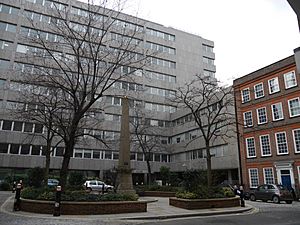Robert Waithman facts for kids
Robert Waithman (1764 – 6 February 1833) was an important British politician. He started his career as a successful cloth seller, also known as a draper. Later, he became a politician who wanted to make things better. He was part of the Whig political party, which supported progress and change. He served as an alderman in the City of London. An alderman is a senior member of a city council. He was even chosen to be the Lord Mayor of London for one year. This was a very important and ceremonial role.
Contents
Robert Waithman's Life Story
Early Life and Business
Robert Waithman was born in 1764 in a place called Wrexham. His father, John Waithman, worked as a joiner, which is someone who builds things with wood. His mother's name was Mary Roberts.
When he was older, Robert worked in a shop in London that sold linen cloth. Around 1786, he decided to open his very own draper's shop. He was very good at business and earned a lot of money. In 1787, he married his cousin, Mary Davis.
Becoming a Politician
Robert Waithman became interested in politics. In 1818, he was elected to Parliament. He represented the City of London as a member of the Whig party. The Whigs were a political group that wanted to make changes and improvements in the country.
He lost his seat in Parliament in the 1820 election. However, he was re-elected in 1826. He stayed in Parliament until he passed away. Robert Waithman was a strong supporter of political reform. This meant he wanted to change laws and the way the government worked to make things fairer.
Important City Roles
Besides being a Member of Parliament, Robert Waithman held other important jobs in the City of London. In 1820, he was chosen to be the Sheriff of the City of London. A sheriff helps with law and order in the city.
Then, in 1823, he was elected as the Lord Mayor of London. This was a very high honor and a big responsibility.
His Legacy
Robert Waithman died in London on 6 February 1833. To remember him, his friends put up a tall, pointed stone monument called an obelisk. It was first placed near his first shop in Ludgate Circus. Today, this obelisk is a main monument in Salisbury Square. It helps people remember his contributions to London and to politics.



